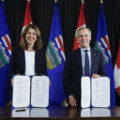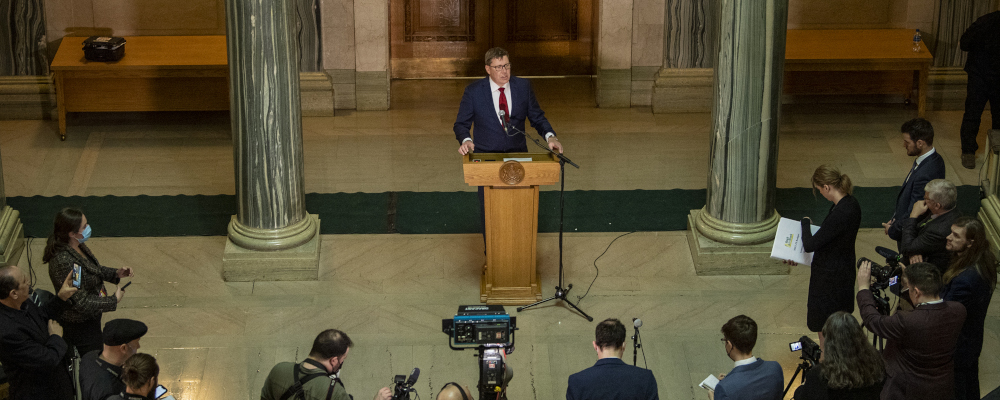Premier Scott Moe vowed to use the notwithstanding clause to override a court ruling that paused the province’s high school pronoun policy last week.
It’s another example of an increased willingness among provinces to use section 33 of the Charter and, in the case of Saskatchewan, to use it preemptively, before the courts have made a judgment on a law’s constitutionality.
Here at The Hub, we’ve assembled some of the country’s top legal minds for their instant reactions to the ongoing controversy.
Moe needs to make a more convincing case
By Joanna Baron
The Saskatchewan dispute over preferred pronouns and Premier Scott Moe’s decision to pre-emptively invoke the notwithstanding clause is a fairly classic example of a case where the judiciary and legislature, based on their different informational inputs, have arrived at different conclusions about the content of rights.
To the King’s Bench judge who granted an interlocutory injunction against the policy, the risk of irreparable harm to trans youth was sufficiently made out. The Moe government, meanwhile, mirrors the overwhelming democratic preference for “parental rights,” for parents to be consulted in their child’s decision to socially transition. The policy only applies to children under the age 16.
At the court hearing, there was credible evidence brought on both sides. UR Pride’s experts focused on the mental health risks associated with a lack of support for a gender-diverse child. The government of Saskatchewan, for its part, tendered evidence from a Berkeley clinical psychologist who testified that parental involvement, as well as a professional assessment and medical plan, in youth gender identity was essential to avoid long-term gender dysphoria and other harms.
The thrust of UR Pride’s argument for the long-term risks of the preferred pronouns policy is that it presents dangers to the “minority within a minority,” the highly vulnerable group of gender-diverse youth who fear coming out to their parents as trans and thus would be prejudiced by a policy requiring parental consent prior for preferred pronouns. The policy does somewhat account for situations where harm may be present:
“In situations where it is reasonably expected that gaining parental consent could result in mental, physical, or emotional harm to the student, they will be directed to the appropriate school professional(s) for support.”
“Reasonably expected” accords a wide latitude for teachers and school staff to make judgments about a child’s home environment and, hopefully, exercise discretion accordingly.
By invoking the notwithstanding clause, Saskatchewan is signalling that it has a different interpretation of how to balance the rights of parents and children in a context where rapid onset gender dysphoria is on the rise, that includes a protected role for parents. It has turned its mind to accommodations where a child may be at risk. What remains to be seen is exactly what this interpretation is.
This week, Moe scrummed and claimed that s. 33 was intended to balance rights protected in the Charter with those not included (like parental rights). This is a bizarre take, and given that a government invoking the notwithstanding clause bears the political consequences of it, he will need to make a more compelling case.
Invoking section 33 is surprisingly cost-free for politicians
By Sean Speer
In light of the recent use of the notwithstanding clause, there have been calls to constrain its invocation through some mix of legislative and constitutional action. I’ll leave it to others to debate the merits (or demerits) of these legalistic proposals.
It seems to me though that a lot of these arguments fail to account for the principal constraint envisioned by those involved in drafting the 1982 Constitution: politics.
It was assumed that politicians would need to consider the political trade-offs involved in invoking S.33 and that the inherent political costs of doing so would weigh heavily on their decisions. The basic idea was that, in a diverse and pluralistic society, there would be few issues with clear majority positions and therefore fragmented and shifting public opinion would serve as a check on the notwithstanding clause.
It prompts the question: why haven’t politics acted as a greater constraint in recent years? I would point to two explanations.
The first is that judicial decision making has itself become political by which I mean it has come to too often advance conventional left-wing political views divorced from the constitution, and as a result eroded the distinction between the judiciary and the legislature. If the courts are going to effectively substitute their own political preferences for those of the duly elected legislature, it’s not a huge surprise that at some point politicians are going to push back. And it’s hard not to blame them. Who’s better placed to do social policy? Parliament or judges?
That many in the world of legal commentary and scholarship seem to believe that it’s the latter speaks to how we’ve ended up with the growing use of the notwithstanding clause. It reflects a general and specific corrective to a judiciary that has become unmoored from its institutional responsibility.
(I would say in parenthesis that I became personally motivated about judicial overreach in the aftermath of the Carter decision on physician-assisted death. It’s not because I was strongly opposed to the decision per see [though on balance I probably oppose the legal regime that’s followed it] but rather that we could get a unanimous decision on a new right to physician-assisted death barely twenty years after the same court had ruled that no such right existed. The 2015 decision laid bare in my mind [and the minds of many other Canadians] that the courts aren’t interpreting the constitution so much as rendering political judgements based on a combination of their read of the public mood and the political preferences of the judges themselves.)
A more circumscribed judiciary—one that “stayed in its lane”—would restore greater balance to Canada’s civic architecture and lead to less use of the notwithstanding clause.
The second factor is a bit more surprising and difficult to explain. There has been less political reaction to its use. The costs have been lower than one might have expected.
One explanation is that governments have invoked S.33 on a judicious basis and only selected cases in which the political costs are minimal. If so, then it might be the case that the initial assumptions about the constraining role of politics have proven generally correct. We haven’t for instance seen Canadian governments use the notwithstanding clause to suspend judicial decisions on highly contentious issues like abortion or same-sex marriage or even physician-assisted death.
There are exceptions though such as Quebec’s Bill 21 where one would assume that the political costs of infringing certain rights would come with bigger costs. Governments should in theory be facing greater opposition from political opponents, stakeholder groups, and citizens themselves for their choices. That they’re not in practice risks undermining a key transmission mechanism embedded in the notwithstanding clause.
(Bill 21 is an interesting example where federal politicians have justified their silence on the grounds that there isn’t much that they can do from a legal standpoint to overturn the Quebec government’s policy. This position however neglects the influence that their political opposition may have on the public debate including for those within Quebec who may be hesitant to actively oppose the legislation.)
The upshot: instead of trying to curtail S.33 or get rid of it altogether, critics of the notwithstanding clause should agitate and organize against its use in order to raise its political costs. That would help to restore the balance that was struck in the 1982 Constitution and ensure that it continues to be used carefully and judiciously.

A taboo well and truly broken
By Dave Snow
Not long ago, the notwithstanding clause was taboo, a “paper tiger” outside Quebec that would spell doom for any government choosing to invoke it. Those days are long gone. If Saskatchewan’s proposed parental consent legislation passes, provinces will have introduced eight bills invoking the clause since 2017, and six of those will have received royal assent. Moreover, all four provincial governments that have introduced bills invoking section 33 have subsequently been re-elected to larger majorities than they had at dissolution.
As the political taboo has faded, scholarly debate over the clause has thrived. My research-in-progress has identified over 30 peer-reviewed pieces published on the notwithstanding clause since 2018. The quality is generally superb, with scholars both more and less favourable towards the clause engaging with thoughtful interpretations of political history. Unfortunately, this nuance often evaporates as soon as legal advocacy groups and experts are asked to comment on the clause in major media outlets. For instance, Saskatchewan’s proposed use has been denounced as the “nuclear option” that will “destroy the rights of students,” a “horrifying” idea that “undermines the very idea of rights protection for all.”
Whenever a premier proposes invoking the clause, legal commentary in major outlets takes on a familiar two-part refrain: first, the clause should only be used as a “very last resort” (an argument I have argued is unsupported by the text, history, and Supreme Court doctrine on section 33). Second, if the clause is invoked in response to a judicial decision, its use “in these circumstances” is “extremely concerning.” (I have yet to see a notwithstanding clause skeptic identify a circumstance in which its use wasn’t concerning.)
Collectively, this legal commentary takes on the character of “heads I win, tails you lose”: the notwithstanding clause should never be invoked before a judicial decision, and if it is invoked in response to one, that particular use is wrong. With the political taboo over the notwithstanding clause broken, we need to have more sophisticated conversations about the competing rights, interests, and values at stake whenever the clause is invoked. The scholarship has moved on—our media commentary should too.
An appropriate response
By Stéphane Sérafin
Saskatchewan’s use of S.33 was an appropriate response to the challenge brought in this case. While lawyers and judges in Canada have grown accustomed to deference from the legislatures on matters of social policy, there is no reason to think that such deference should be given in every case. Certainly, universal deference was not contemplated in our constitutional settlement, which wisely provided for the inclusion of S.33 alongside the grant of judicial review powers for enumerated rights. No particular difficulty arises from the prospective use of S.33 either, which has precedent in Quebec.
The case at hand furnishes a particularly good illustration of the reasons for which this constitutional settlement was reached in the first place. Although the dispute has been framed on both sides as a matter of “rights,” this framing reflects a political and legal culture that has become too centred on rights-based judicial review.
In reality, the core of the dispute pertains to whether parents ought to be given the full information necessary to fully discharge the duties that they generally assume towards their children. The groups behind the Charter challenge believe that schools should withhold information and perhaps even actively mislead parents on one specific subject, namely, on whether children have decided to change their names and genders on official school lists. It is hard to see how a Charter challenge, whether successful or not, could have contributed constructively to the public discussion that ought to take place on this issue.
Recommended for You

‘Uncertainty costs money’: Can Canada attract the investment needed to build major energy projects?

‘A populist, nationalist movement’: What is AmericaFest—and why should Canadians be paying attention?

Bondi Beach is a warning Canada cannot ignore

Are younger Canadians getting their fair share? It’s time to have a serious talk about the CPP



